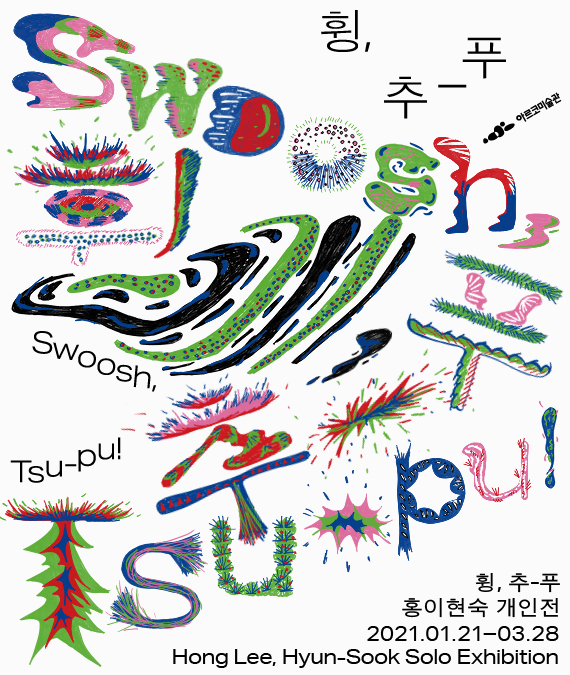전시
-
홍이현숙 개인전《휭, 추-푸》
- 전시기간
- 2021.01.21~2021.03.28
- 관람료
- 오프닝
- 별도의 초대일시 없음
- 장소
- 아르코미술관 제1,2전시실
- 작가
- 홍이현숙
- 부대행사
- 퍼포먼스 및 강연(자세한 사항은 본문 참고)
- 주관
- 아르코미술관
- 주최
- 한국문화예술위원회
- 문의
첨부파일
홍이현숙 개인전《휭, 추-푸》
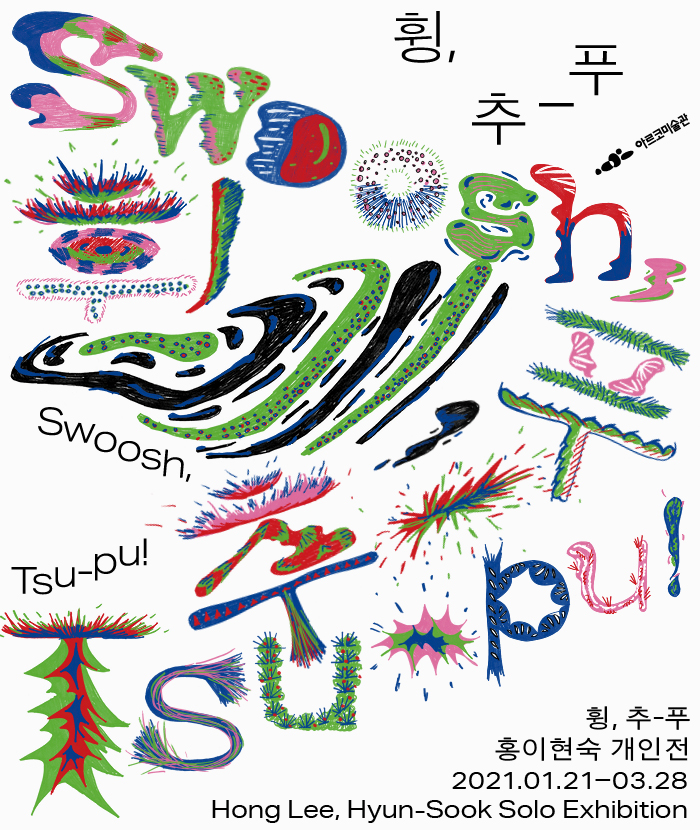
전시관람 온라인 사전예약 링크 : https://booking.naver.com/booking/12/bizes/447542
※사전신청은 선착순 예약제로 운영되며, 사전신청 가능인원은 1명당 2명까지 신청가능합니다.
※사전신청 후 방문이 어려울시 방문일 하루 전까지 사전취소 부탁드립니다.
※온라인 사전예약 접수를 우선으로 하며, 온라인 사전예약 미달 및 취소 시 해당 인원수에 한정하여 현장 접수가 가능합니다.
▣ 전시개요
- 제목 :《휭, 추-푸》
- 기간 : 2021.1.21-3.28
- 오프닝 : 별도의 초대일시 없음
- 장소 : 아르코미술관 제1,2전시실
- 작가 : 홍이현숙
- 부대행사 : 퍼포먼스 및 강연(자세한 사항은 본문 참고)
- 주관 : 아르코미술관
- 주최 : 한국문화예술위원회
아르코미술관은 2000년대 중반부터 동시대 미술이 주목하고 있는 예술적· 사회적 의제를 다뤄온 작가의 신작을 선보였고 이를 통해 지속적인 창작활동이 가능한 환경 조성에 주력해왔다. 올해 선정 작가인 홍이현숙(b.1958)은 가부장적 사회와 시선에 저항하는 주체적이고 자유로운 몸을 퍼포먼스, 영상, 설치 등 다양한 매체로 이야기해왔으며 한국 여성주의 미술의 대표 작가로 평가받는다.
활발한 작품 활동 외에도 아르코미술관이 홍이현숙 작가를 주목하는 이유는 사회 구조적 문제로 인해 소외된 존재들을 예술의 영역으로 끌어들여 가시화했던 실험적인 기획과 프로젝트에 있다. 작가는 다수의 공공미술 프로젝트 기획을 통해 낙후되거나 사라지는 터전과 지역민의 삶을 고민했고, 동료들과의 협업을 통해 다양한 프로그램을 구성하기도 했다.
이번 아르코미술관에서의 《휭, 추-푸》는 연대와 협력을 강조했던 지난 작품과 연장선에 있으면서 비인간 존재들에게로 그 관심을 확장한다. 더불어 겪어보지 못한 새로운 세계의 감각을 구현해야하는 예술가의 고민 또한 반영한다.
제목 ‘휭, 추-푸’에서 ‘휭’은 바람에 무언가 날리는 소리, ‘추푸’는 어딘가에 부딪히는 소리이다. ‘추푸’는 『숲은 생각한다』(2018)(에두아르도 콘 지음, 차은정 역, 사월의책)에서 인용했으며, 케추아어(남아메리카 토착민의 언어)로 동물의 신체가 바람에 휘날리거나 수면에 부딪히는 모습을 의미한다. 이러한 맥락에서 전시 제목에 의성어나 의태어를 사용함은 인간의 한정된 언어가 아닌 열린 소리와 몸을 사용하여 인간/비인간이라는 근대의 이분법적 논리를 극복하고 비인간 동물과 동등하게 소통하려는 시도와 의지가 담긴 것이다.
전시장에는 인간의 청각 범위를 초월하는 고래의 소리와, 재개발 지역의 골목에 남아 인간의 애정 어린 시선과 혐오의 눈길을 동시에 견디며 살아가는 길고양이 등이 소환된다. 작가는 그들과 우리가 서로 삶의 공간을 공유하고 있음을 인지하고, 함께 헤엄치고 날아다니는 상상의 결과를 전시장에 펼친다. 또한 작품을 통해 비인간 동물이 겪는 고통이 곧 우리가 마주하고 있는 위기임을 의식하게 만든다.
공멸과 공생 사이에서 위태로운 현재, 그래서 미래를 감히 상상하기 힘든 뉴노멀(New-Normal)의 시대에 홍이현숙은, 인간을 포함한 모든 존재들과의 새로운 연대와 공생이 가능한 장소를 예술을 통한 상상으로 열어 보고자 한다.
홍이현숙 개인전 《휭, 추-푸》 티저영상 https://www.youtube.com/watch?v=qu4dts5BijQ
작가 인터뷰 영상 https://www.youtube.com/watch?v=cw7FqIpBgHU
큐레이터 전시 설명 영상 https://www.youtube.com/watch?v=qE4mn6kaKUQ
▣ 주요 작품 소개
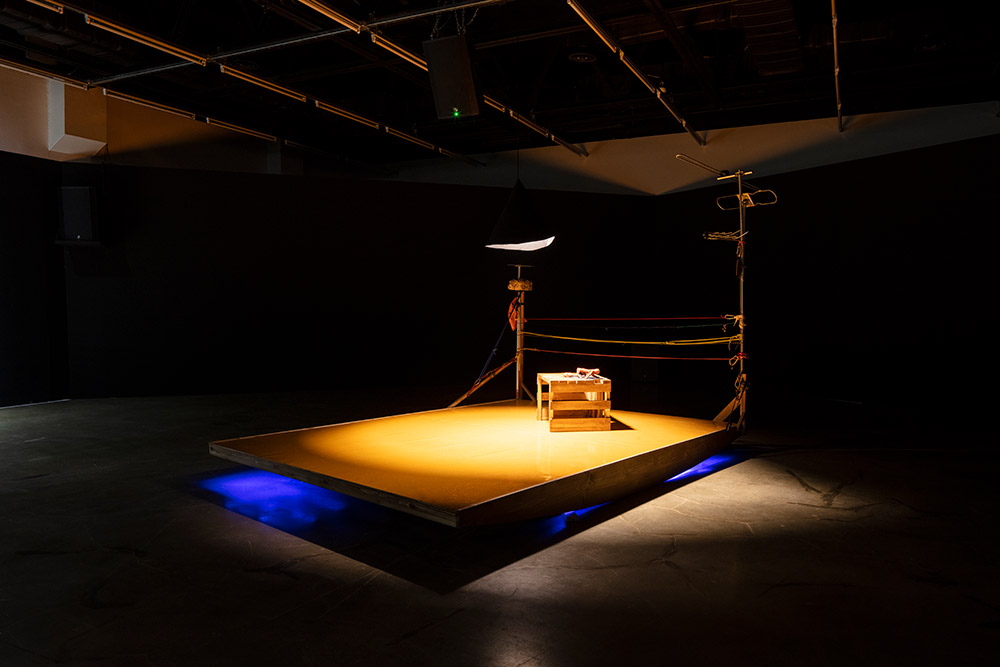
여덟 마리 등대, 2020, 스피커 8대(사운드 13분 1초), 가변크기
고주파와 저주파 음역대를 오가는 고래의 소리는 깊은 바다를 누비는 동족 간 소통의 도구이자 외부 세계를 인지하는 매개이다. 그러나 최근 선박과 비행기 등이 만들어내는 소음으로 그들의 목소리는 점점 힘을 잃고 있으며 심각한 경우 귀가 멀거나 길을 잃기도 한다. 작가는 인간의 언어로 온전히 들을 수도, 묘사할 수도 없는 고래 8종의 목소리를 MBARI(몬터레이만 아쿠아리움 연구소, Monterey Bay Aquarium Research Institute)가 녹음한 데이터를 변형하여 전시장에 재생한다. 소리를 통해 자신들의 세상을 탐구하는 고래들처럼, 관객은 뗏목처럼 만들어진 작가의 열린 ‘방’에 누워 바다를 느끼며 함께 유영한다. 고래의 목소리로 만들어진 세계는 관객의 신체와 맞닿아 공감각적인 경험을 만들어낸다.
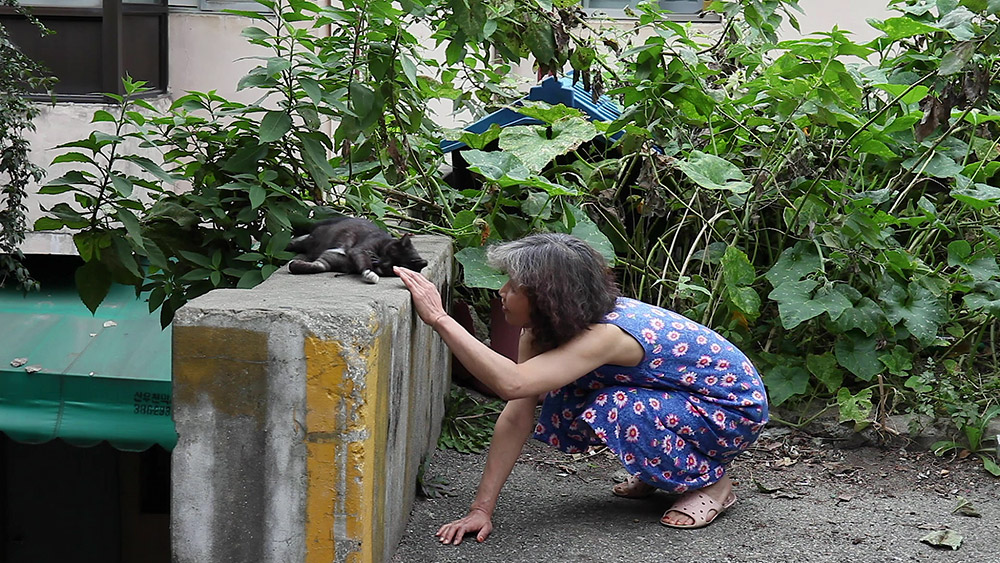
석광사 근방, 2020, 단채널 비디오, 컬러, 사운드, 15분 45초
석광사는 은평구 갈현동에 위치한 작은 절이다. 재개발 예정지이기도 한 이 지역의 골목에는 많은 길고양이들이 배회하고 살아간다. 석광사는 산신이 타고 다니는 호랑이상을 모시는 장소이고 호랑이는 영성과 신성을 상징하는 영물로 추앙받지만, 같은 고양이과임에도 길고양이들은 인간에게 애정과 동정, 혐오의 대상이 되어 좁은 골목과 틈 사이를 아슬아슬하게 오간다. 작가는 인간과 함께 삶의 공간을 공유하고 있지만 동시에 인간과 환경의 변화로 인해 생존을 위협받는 이들과 소통을 시도한다. 조심스레 눈높이를 맞추고, 움직임을 따라하거나 그림자로 그들의 신체를 쓰다듬고, 등에 올라 타 함께 날아오르는 상상을 하며 인간과 비인간 동물이 쌓은 시간이 사라질 공동의 터전을 내려다본다.
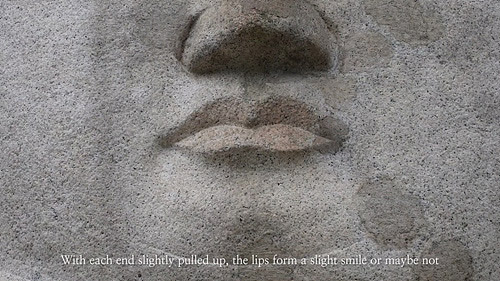
지금 당신이 만지는 것, 2020, 단채널 비디오, 컬러, 사운드, 17분 47초
비대면이 주요한 키워드가 된 시대, 접촉이 금기시된다면 촉감 등 직접적인 경험을 통해 얻었던 감각은 이제 어떻게 체득될 수 있을까. 밖이 아닌 가상의 공간에서 이는 어떻게 구현될 수 있을까. 이러한 질문을 바탕으로 작가는 북한산 승가사에 위치한 마애불을 바라보며 손으로 화강암을 만졌던 경험을 떠올린다. 까슬한 화강암으로 이루어져있는 마애불은 그 거대한 크기 때문에 한눈에 담기도 어렵지만, 문화재이자 종교적 상징성으로 인해 쉬이 만질 수 없는 대상이기도 하다. 그러나 만질 수 없는 것을 만지기 위해 작가는 손대신 카메라로 가까이, 그리고 멀리서 불상을 천천히 훑고 어루만지며 그 상상된 촉감과 감상을 관객에게 설명한다. 마치 ASMR(Autonomous Sensory Meridian Response)처럼, 작가의 목소리를 통해 관객은 닿을 수 없는 존재와의 접촉을 상상하며 제3의 감각을 그려본다.
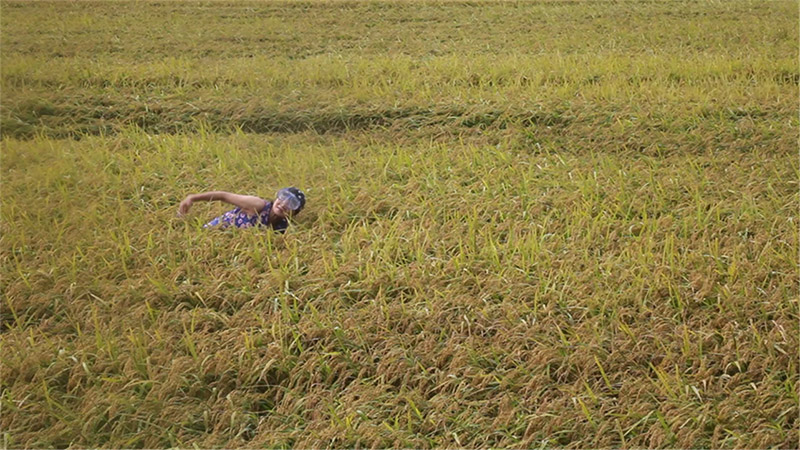
각각의 이어도, 2020, 4채널 비디오, 컬러, 사운드 1채널: <논 속 수영>, 1분 4초 2, 3채널: 이어도 종합해양과학기지 실시간 cctv 재생 4채널: <물속 숨소리>, 4분 42초
해양과학기지가 설립된 이어도는 수중암초이자 전설에 등장하는 유토피아이다. 동시에 미래를 예측하고 영역을 확장하고자 하는 인간의 욕망이 담긴 현장이기도 하다. 2개의 화면에는 이어도해양과학기지의 cctv를 통해 이어도 주변 바다의 모습이 실시간으로 재생되어 갈 수 없는 이어도를 상상할 수 있다. 또한 출렁이는 벼에서도 바다를 발견한 작가는 논 속을 헤엄치며 바다를 느끼고, 심해에서 부력에 저항하며 자유롭게 몸을 움직여본다. 마지막으로 바닷속을 유영하는 스쿠버의 깊은 숨소리는 이 네 개의 화면을 아우른다.
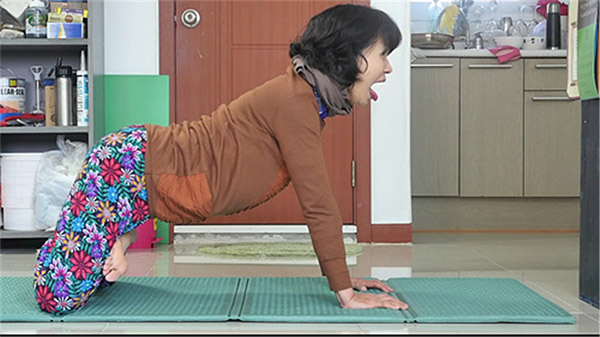
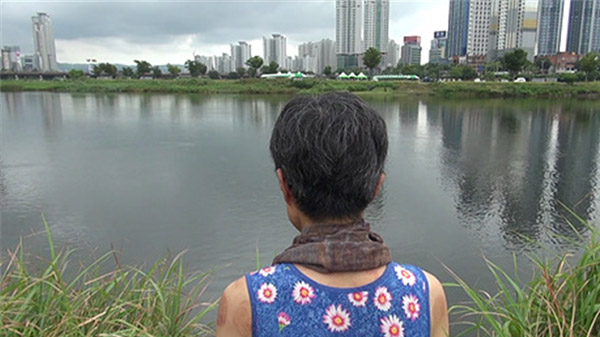
(위)사자자세, 2017, 컬러, 사운드, 4분 11초
(아래)고래자세, 2018, 컬러, 사운드, 7분 7초
고래의 소리를 인간의 언어로 받아쓰기, 사자의 모습과 소리를 흉내내기는 작가에게 있어 그들을 이해하고자 하는 시도이다. 물론 내가 아닌 존재가 되어본다는 것은 결국 실패하는 일이며, 의인화한다는 비판에서 벗어나기 어려울 것이다. 작가는 이를 인지하면서도 공통의 언어를 찾으려는 수행을 끊임없이 반복하여 비인간 동물을 이해하고 그들과 교류할 수 있는 단서를 찾아보고자 한다.
▣ 연계 행사
|
제목 |
일정 |
참여자 |
내용 |
|
|---|---|---|---|---|
|
1 |
홍이현숙x박수지: 일곱 개의 질문 |
2021.1.7 |
박수지 (독립큐레이터) |
전시장에서의 1:1 토크를 통해 작가 및 전시에 대한 집중적인 토론 및 논의 공유 |
|
2 |
비봉 소리요가 |
2021.2.4. |
요건요가팀 (구윤지, 윤현길, 정주연, 조영주, 최연하, 허윤희, 황수경, 홍이현숙) |
미술관에서 울리는 고래소리의 진동이 인간의 몸을 두드리는 경험을 받아들이고, 그 감각을 다시 인간의 소리로 발화하는 성대 요가 |
|
3 |
전시에서 비인간 동물을 호명하기(가제) |
2021.2.18 |
박수진(독립큐레이터), 윤민화(독립큐레이터) |
비인간 동물을 키워드로 홍이현숙의 작품 세계 분석 및 탐구 |
|
4 |
길을 잃을 줄 아는 물의 목소리 |
2021.3.4 |
작가그룹 득능막망 (강현아, 김준아, 김현주, 리금홍, 윤결, 이상호, 이수영) |
작가 그룹 ‘득능막망’ 멤버들이 참여하여 전시 출품작에 대한 집단 크리틱 퍼포먼스 기획 |
|
5 |
바다생물 다라니(陀羅尼) |
2021.3.25 |
김수진, 이상호, 조미영, 홍이현숙 |
바다생물을 위한 경(經) 낭독회. 관객 참여형 퍼포먼스 |
* 프로그램 중 일부는 아르코미술관 유튜브(ARKOArtCenter, https://www.youtube.com/user/arkoartcenter/videos)를 통해 다시 볼 수 있습니다.
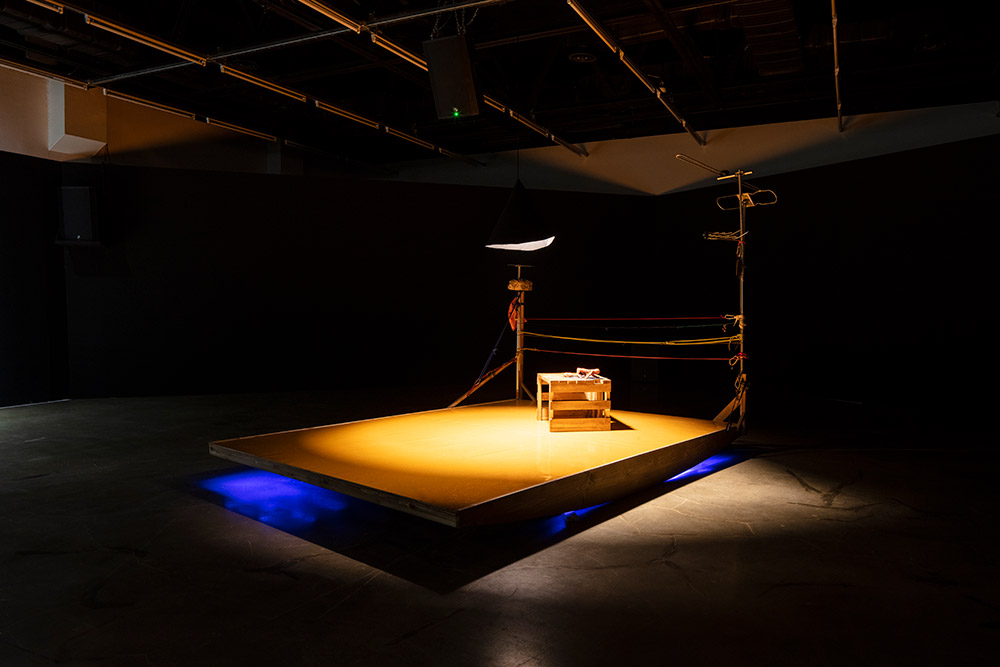
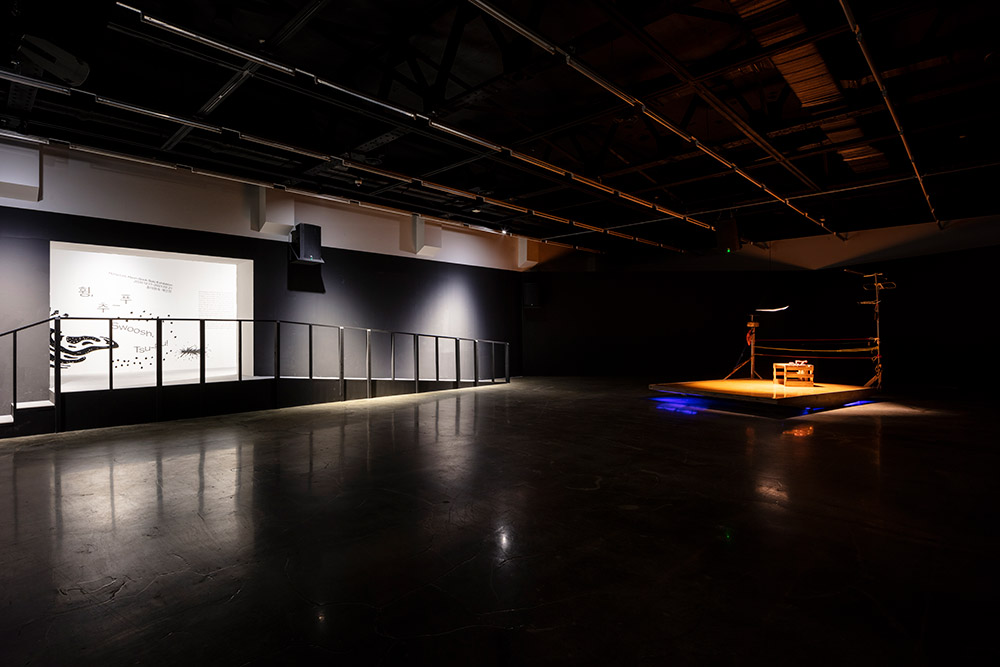
1층 전시 전경
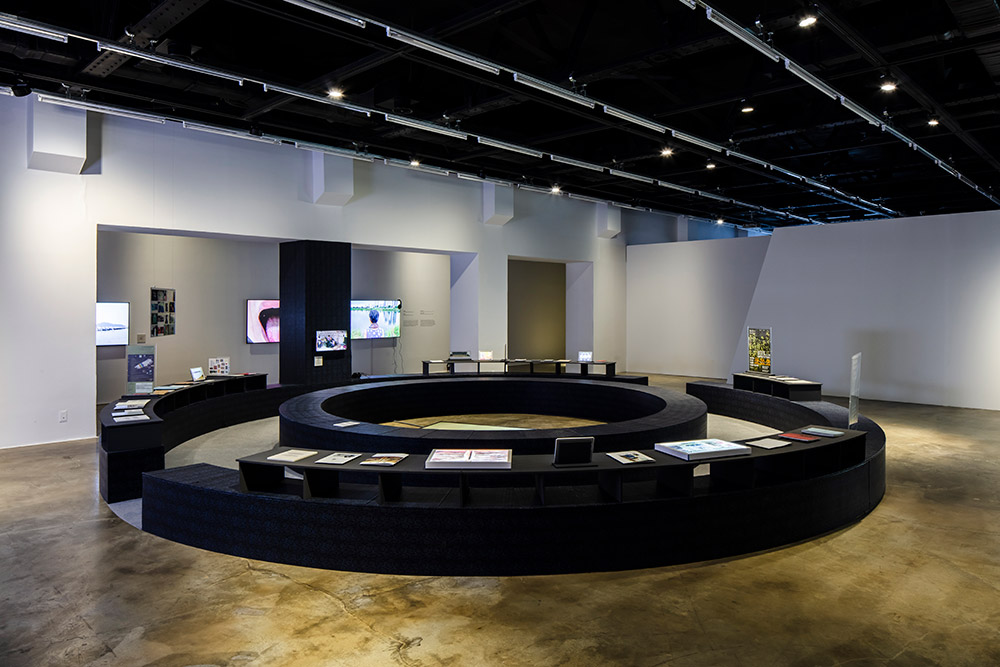
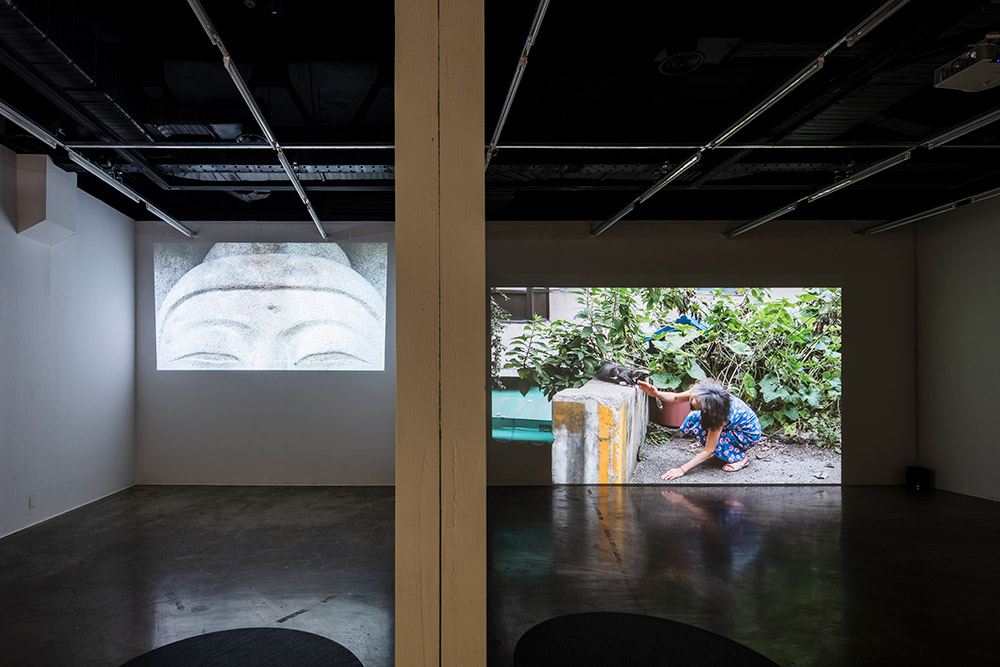
2층 전시 전경
자료담당자[기준일(2020.12.21)] : 아르코미술관 김미정 02-760-4617
게시기간 : 20.12.21 ~
Hong Lee, Hyun-Sook Solo Exhibition
- Date : 2021.1.21.-3.28
- Opening : There will be no opening reception
- Location : ARKO Art Center Galley 1, 2
- Artist : Hong Lee, Hyun-Sook
- Program : Performance and Lecture (Please refer to the text for details.)
- Hosted by : ARKO Art Center

● Exhibition Online Advance Booking Link: https://booking.naver.com/booking/12/bizes/447542
※ Advance booking is operated on a first-come, first-served basis. Up to 2 people per person can apply in advance.(Admission is free)
※ If it’s difficult to visit after booking in advance, Please cancel one day before your visit date.
※ Priority is given to online advance booking. In case of insufficient online reservation or cancellation, on-site booking is possible only for the number of people involved.
Since the mid-2000s, ARKO Art Center has been organizing exhibitions supporting new works by mid-career Korean artists, intending to provide an environment for them to continue their art practice. This year, the museum presents Hong Lee, Hyun-Sook(b. 1958), who uses various media, such as performance, video, and installation, to produce works that discuss the free, independent body that resists the patriarchal society and gaze. She has been recognized as a leading artist in the history of Korean feminist art.
Another reason why ARKO Art Center has paid attention to Hong Lee is her experimental curatorial events and projects, which bring those overlooked by the social structure into the realm of art and make them visible. In many public art projects, the artist contemplates the places that are outdated and no more visible and their residents ̕ lives. She has presented projects where her own body or fellow artists ̕ works expand the voice of social minorities. These projects were done in many different locations, and they were open to everyone.
The exhibition Swoosh, Tsu-pu! is an extension of her older works that highlight solidarity and cooperation. It deals with non-human animals as the central theme, imagining and striving to live in symbiosis with them. The exhibition is in line with Ecofeminism, which aims to free nature from the human-centered dualism and stand in solidarity with it. The show also reflects the artist̕s contemplation on materializing the sense of a new world, which one hasn̕t experienced until now.
In the unusual exhibition title Swoosh, Tsupu!, the word “swoosh” may sound like the wind moving and “tsu-pu” like something thrown onto the surface of water. “Tsu-pu” is Quechuan (the language of South American natives), functioning like an onomatopoeia or ideophone, such as "flop" or “splish splash.” Unlike human languages that require one to understand a particular society or culture to speak, these mimetic words, added with gestures explaining the situation and different sounds, can mediate the communication despite boundaries among different beings. With this title Swoosh, Tsu-pu!, the artist hopes to avoid limited languages or ways of thinking to define or judge other beings, including humans and non-human animals. She tries to be in an equal position with them to exchange views. She encourages one to reject the narrow-minded idea of just blaming humans and sympathizing with non-human animals and open their five senses to perceive and understand each other.
The exhibition invokes whales whose songs transcend the human hearing range and cats that stay in the redevelopment area̕s alleyways and tolerate human affection and hatred. The artist imagines being able to swim and fly with them in a space where we human beings and they come together. Moreover, she helps us see that their suffering is the crisis that we face.
Between co-destruction and coexistence, the present is at risk; therefore, one cannot even dare to visualize their future in this New-Normal period. Despite the possibilities of failures, Hong Lee uses her artistic imagination to open the door to a new kind of solidarity and coexistence with all beings, including humans.
*The word “tsu-pu” is from Eduardo Kohn’s book How Forests Think (Supeun Saenggakanda, trans. Cha Eunjeong, Aprilbooks, 2018).
Teaser https://www.youtube.com/watch?v=qu4dts5BijQ
Artist Interview https://www.youtube.com/watch?v=cw7FqIpBgHU
Online Exhibition https://www.youtube.com/watch?v=qE4mn6kaKUQhttps://www.youtube.com/watch?v=qE4mn6kaKUQ
▣ Featured Works

Eight, Lightvessels, 2020, eight speakers(13min 1sec), variable dimensions
The sounds that whales make range from high frequencies to low frequencies. It is a communication tool with their family groups while they travel in the deep sea, and it functions as a mediator for perceiving the outer world. However, the noises from ships and airplanes make the whales’ voices weaker, and in the worst case, they become deaf or get lost. The artist distorts a recording of eight different whales, which human beings cannot hear or elaborate, and plays it in the exhibition space. The recording was done by MBARI. Like whales that explore their worlds through sounds, audiences lie down in an open “room” that resembles a raft, feel the ocean, and float together. The world made up of the whales’ voices comes in contact with the audiences’ bodies and creates a multi-sensory experience.
Sound Editing Assistant: Jinseung Jang Sound Mixing Technicians and programmers: Sang-Hyun Kim, Seokbin Oh The original sound recording of the whales was generously provided by MBARI(www.mbari.org).

In the Neighborhood of Seokgwangsa, 2020, single-channel video, color, sound, 15min 45sec
Seokgwangsa Temple is a small temple in Galhyeon-dong of Eunpyeong District. The area is part of the city's redevelopment plan, and many stray cats roam around and dwell in its alleyways. Seokgwangsa Temple houses a statue of the tiger that the mountain god rides. The tiger is considered a divine creature, admired as a symbol of spirituality and a godly representation. Though both cats and tigers belong to the same family of animals, stray cats become objects of human affection, sympathy, and hatred and dangerously cross across the narrow streets and their gaps. The artist makes an effort to communicate with these cats whose lives are threatened by humans and the changes in their surroundings while they share their living space with humans. She carefully observes them from their perspective, mimics their movements, strokes their bodies using her shadow, and imagines to ride on their back and soar up together. While doing that, she looks down on the shared space where the time that human animals and non-human animals have accumulated together will soon be absent.
Film Editor: Keesoo Lee, Minju Jeong Drone Filming: Hyunsuk Lee

What You Are Touching Now, 2020, single-channel video, color, sound, 17min 47sec
We now live in an era of remote interaction. If one is prohibited from being in contact with others, how can they obtain the senses that used to be learned through direct experiences such as touch? How can one realize them in a virtual space, which is not a physical space? Based on these questions, the artist looks at the Maaebul [image of Buddha carved on large rock outcrops or cliffs] in Seunggasa Temple, remembering her experience of touching the granite with her hand. It is hard to look at the whole Maae-bul made of rough granite all at once because of its massiveness. One cannot easily put their hands on the statue since its status as a cultural heritage and its religious symbolism. However, to touch what she cannot, the artist uses a camera instead of her hand, closely and from a distance, slowly scans and caresses the Buddha statue, and explains the touch and impression that she imagines to audiences. As they do with ASMR, audiences imagine coming in contact with what they cannot reach—envisioning the third sense through the artist’s voice.

Each One’s Own Ieodo, 2020, multi-channel, video, color, sound
Channel 1: Swimming in the Rice Paddy, 1min 4sec
Channel 2, 3: Live streaming from the Ieodo Ocean Research Station’s CCTV cameras
Channel 4: The Sound of Underwater Breathing, 4min 42sec
Ieodo, where the Ocean Research Station was built, is a submerged reef and a utopia that appears in a legend. Simultaneously, it reflects human desires to foresee the future and expand their territories. Two of the four screens live broadcast the ocean around Ieodo through the Ieodo Ocean Research Station's security cameras, allowing audiences to picture Ieodo that they cannot go. The artist also sees an ocean in swaying rice. She swims in the rice field, feeling the water, and she freely moves around, resisting the deep sea's buoyant force. At last, the breathing sound of a scuba diver swimming underwater encompasses the four screens.
This project received assistance from the Ieodo Ocean Research Station under the Korea Hydrographic and Oceanographic Agency and Junsung Lee(Society of Ieodo Research).


Being a Lion, 2017, single-channel video, color, sound, 4min 11sec
Being a Whale, 2018, single-channel video, color, sound, 7min 7sec
For the artist, transcribing whale sounds into human languages or mimicking a lion’s image and sounds signals her efforts to understand these animals. Such an attempt to become the other is not only doomed to fail, but it also cannot escape criticism that demeans the efforts as mere personifications. Fully aware of such criticisms, the artist still endeavors to find a common language to understand and communicate with the non-human animal other.
▣ Related Programs
|
Title |
Date |
Attendees |
|
|---|---|---|---|
|
1 |
Hong, Lee Hyun-Sook x Suzy Soma Park: Seven Questions |
2pm, Thursday, 7 January, 2021 |
Suzy Soma Park (Independent Curator) |
|
2 |
Bibong Sound Yoga : With Whale in ARKO Art Center |
2pm, Thursday, 4 February, 2021 |
Bibong2gil (Koo Yoonji, Yoon Hyungil, Jung Juyeun, Cho Youngju, Choi Yeonha, Heo Yoon-hee, Hwang Sukyung and Hong Lee, Hyun-sook) |
|
3 |
Invoking Non-human Things in Exhibition : Focusing (Based) on Hong Lee, Hyun-sook's Work |
2pm, Thursday, 18 February, 2021 |
Hong Lee, Hyun-sook, Park Soojin(Independent curator), Yun Minhwa(Independent curator) |
|
4 |
A Voice of Water that Knows How to Get Lost |
2pm, Thursday, 4 March, 2021 |
Artist collective Deuk-neung-mak-mang (Kang Hyun-ah, Kim Junah, Kim Dalo Hyunjoo, Lee Geumhong, Yoon Gyeol, Lee Sang-Ho, Lee Sooyoung) |
|
5 |
Reading Club: “I'm with the Bears” |
How to participate: TBA |
|
|
6 |
Reading Performance: Dharani for Underwater Animals |
How to participate: TBA |


Exhibition View


Exhibition View
자료담당자[기준일(2021.1.29)] : 아르코미술관 김미정 02-760-4617
게시기간 : 21.1.29 ~
